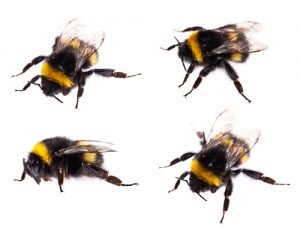Meet the Bumble Bee
By Chris Williams on March 28, 2012.
Although the honey bee gets more press as a pollinator, the bumble bee is one of the hardest workers in the insect world: gathering nectar and pollen until the pollen sacs on her hind legs are so loaded that she can barely fly, until the stem of every flower she lands on bends toward the ground. She performs a valuable service, especially in the pollination of alfalfa and clover as grazing crops.
 Like the honey bee, the bumble bee is a social bee, living with others in a small colony of up to 200 bees. The colonies don’t survive the winter and nests aren’t reused the following year. In spring, a large, fertile overwintering queen starts a new colony. Bumble bee nests are usually in the ground under a tuft of grass or other plant, or in abandoned rodent burrows or old ground bird nests. They sometimes nest above ground in strange places like in old equipment, abandoned furniture, old mattresses, in logs, in bird or mouse nests, or in insulation in sheds or building voids. The new queen raises the first brood of worker bees who then collect pollen to feed to the new bee larvae in the nest, and so on. The colony reaches its maximum size in late August, which coincidentally is the month for most bumble bee complaints.
Like the honey bee, the bumble bee is a social bee, living with others in a small colony of up to 200 bees. The colonies don’t survive the winter and nests aren’t reused the following year. In spring, a large, fertile overwintering queen starts a new colony. Bumble bee nests are usually in the ground under a tuft of grass or other plant, or in abandoned rodent burrows or old ground bird nests. They sometimes nest above ground in strange places like in old equipment, abandoned furniture, old mattresses, in logs, in bird or mouse nests, or in insulation in sheds or building voids. The new queen raises the first brood of worker bees who then collect pollen to feed to the new bee larvae in the nest, and so on. The colony reaches its maximum size in late August, which coincidentally is the month for most bumble bee complaints.
Bumble bees are often confused with carpenter bees. Both are large (3/4 inch or more in length), and black and yellow. One way to tell the difference is that the carpenter bee’s abdomen is hairless, black, and shiny. The bumble bee’s abdomen is fuzzy and banded black with yellow. The carpenter bee is a solitary bee that nests in wood, leaving circular entrance holes that mark the nest.
Bumble bees can sting and will aggressively defend their nest. When their nest is disturbed, they emit a very loud buzzing sound, making it sound like there are many more bees present than there actually are. They will leave the nest and will chase the offender for some distance. Although bumble bees are considered beneficial, when they are nesting near a walkway or in a backyard where children or pets may stumble upon the nest site, the nest should probably be eliminated.
If you have a bumble bee nest in your yard and you know where it is located, control is fairly straightforward. A pest control company can treat the nest site. A nest in a wall void or attic can be treated too, and you’ll definitely want a professional to do that job.